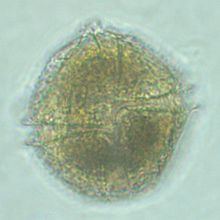Hystrichosphaeridium machaerophorum
| Lingulodinium polyedrum | |
|---|---|
 |
|
| Ventral view of Lingulodinium polyedrum 900x magnification | |
| Scientific classification | |
| Domain: | Eukaryota |
| (unranked): | SAR |
| (unranked): | Alveolata |
| Phylum: | Dinoflagellata |
| Class: | Dinophyceae |
| Order: | Gonyaulacales |
| Family: | Gonyaulacaceae |
| Genus: | Lingulodinium |
| Species: | L. polyedrum |
| Binomial name | |
|
Lingulodinium polyedrum Dodge, 1989 |
|
Lingulodinium polyedrum is a species of motile dinoflagellates (synonym Gonyaulax polyedra), which produces a dinoflagellate cyst called Lingulodinium machaerophorum (synonym Hystrichosphaeridium machaerophorum).
As part of its life cycle, this species produces a resting stage, a dinoflagellate cyst called Lingulodinium machaerophorum (synonym Hystrichosphaeridium machaerophorum). This cyst was first described by Deflandre and Cookson in 1955 from the Miocene of Balcombe Bay, Victoria, Australia as: "Shell globular, subsphaerical or ellipsoidal with a rigid membrane, more brittle than deformable, covered with numerous long, stiff, conical, pointed processes resembling the blade of a dagger. Surface of shell granular or punctate." Its stratigraphic range is the Upper Paleocene of eastern USA and Denmark till Recent.
Organic-walled dinocyst morphology is shown to be controlled by changes in salinity and temperature in some species, more particularly process length variation (processes are sometimes called spines, but that is incorrect because they are not necessarily pointy). This morphological variation is known for Lingulodinium machaerophorum from culture experiments, and study of surface sediments. The morphological variation of process lengths can be applied for the reconstruction of salinity. Process length variation of Lingulodinium machaerophorum has been used to reconstruct Black Sea salinity variation.
Lingulodinium polyedrum has been related to production of Yessotoxins (YTXs), a group of structurally related polyether toxins, which can accumulate in shellfish and can produce symptoms similar to those produced by Paralytic Shellfish Poisoning (PSP) toxins.
Lingulodinium polyedrum produces brilliant displays of bioluminescence in warm coastal waters. Seen in Southern California regularly since at least 1901.
...
Wikipedia
